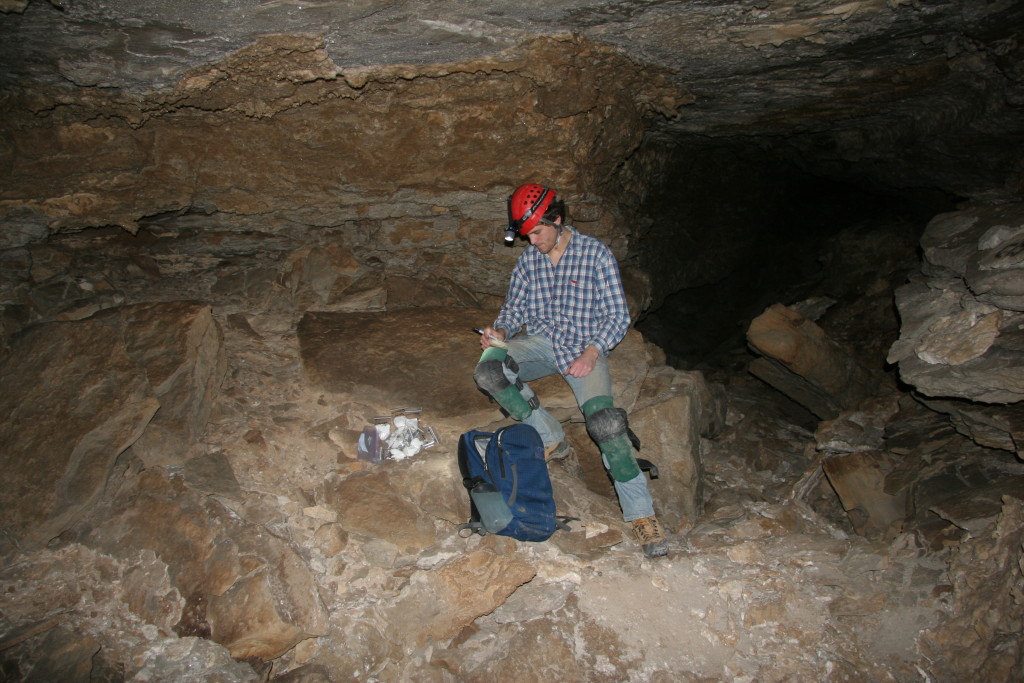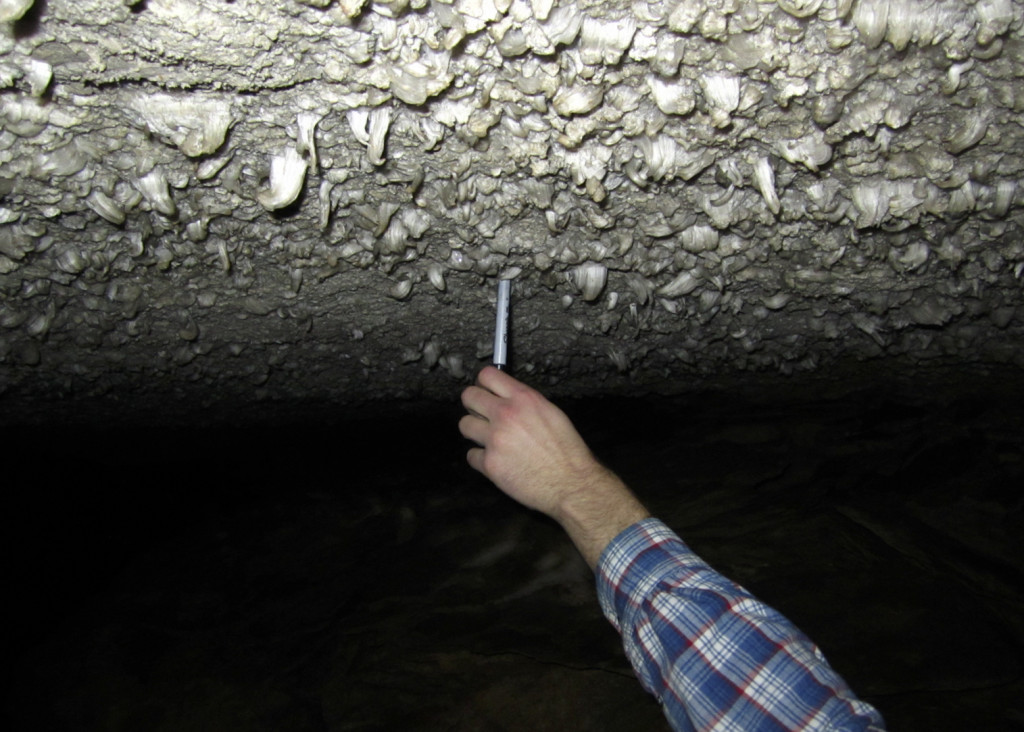Garrecht recently completed his PhD in the Fike Stable Isotope Biogeochemistry Research group at Washington University of St Louis. You can read more about his research here.
Mammoth Cave, located in central Kentucky, USA, earned its name for its size, a near unfathomable length currently mapped at over 640km (~400 miles). This makes it, by far, the longest cave system in the world. Gypsum (CaSO42H2O) lines many of the walls and ceilings of the dry passages. The origin of the gypsum has been debated for nearly a century. Identifying the source of gypsum will increase our understanding speleogenesis (cave formation) and water transport in karst terrains. The Ca and H2O come from the surrounding limestone and water, which leaves the S as the only element with an unknown source. Was bedded gypsum being dissolved elsewhere in or above the cave and later reprecipitated at the cave walls or was pyrite being oxidized within the cave walls? Because each of these minerals have distinct sulfur isotope signatures, we can discriminate between the sources.
We set off in January to the Hamilton Valley Research Facility, base camp for mappers and visiting researchers. It was here that we planned our sampling locations and travel routes. Our plan for subsurface sampling required 16-18 hours of straight sampling due to the long distances between locations. Many of the best gypsum deposits are located on the main tourist trail because the deposits are a major tourist attraction for the cave, but to get wide spatial coverage we had to depart from the main trail.

View from the porch of the Hamilton Valley Research Facility. Fortunately, on the snow day we were doing subsurface sampling in the cave.
The first thing you notice about the cave is the temperature change. While the temperature outside the cave hovered near 0°C the inside was a relatively balmy 13°C. The second thing you notice is that the cave is quiet. Perhaps the quietest place you’ll ever go. Once your ears adjust to the mute surroundings you began to grasp how massive the cave truly is. The passages, etched by carbonic and organic acids in the past few million years, seem to go on endlessly. While I am working with experienced cave mappers there is a still a tangible risk of getting lost down any of the innumerable minor passages. The majority of the cave is located within a few, rather featureless Mississippian-aged limestone units making it even more difficult to identify where we are stratigraphically and also making it easier to get lost. Cave rescues are dangerous affairs and often end tragically. Fortunately, we were able to avoid any real problems and sampling went off without a hitch.

The author labeling gypsum samples. Due to the delicate nature of the samples, they needed to be individually wrapped in tissue paper. At this location, the surface of the gypsum was stained red.

The author resting an arm on a large piece of the ceiling that had fallen. A ~1-2cm gypsum crust is located on the underside of the slab. In some areas of the cave, gypsum forms in cracks in the ceiling. As it grows, it wedges the rock apart, driving collapse of the ceiling.
We sampled gypsum, whole rock, and water from as diverse locations as was possible. The gypsum took the form of blades, crusts, needles, and “snowballs”.

Needle gypsum morphology. Part of the gypsum is stained black, possibly from soot derived from the burning of torches used by the native people and later by American explorers and tourists.
Above the cave we sampled rock from the cave-bearing and overlying stratigraphic units to analyze sulfur isotopes in pyrite and SO42- substituted for CO32- in calcite. This was to make sure we get an isotopic “fingerprint” for all the possible sulfur sources and sample all the cave-bearing and overlying stratigraphic formations. This will help us understand the travel distance of the dissolved sulfur. At the first location we noticed beautiful frost flowers growing along dead plant stems. These form through capillary action where the ground isn’t frozen while the air temperature is below freezing.

Sample locality for the Girkin Sandstone, a cross-bedded quartz sandstone. The red staining is from the oxidation of pyrite. Note the hammer for scale.
Sulfur isotope analyses would reveal that pyrite from the cave-bearing limestones is the major and possibly exclusive sulfur source for gypsum. Pyrite within the cave wall and ceiling is oxidized and then transported a few meters to tens of meters to the cave wall where evaporation drives precipitation of gypsum inside of pores. This causes gypsum to grow from the base, opposite of the way calcite speleothems grow. Sampling every centimeter along the growth axis of single gypsum samples shows that there is no change in sulfur isotope values through the growth history of the gypsum, which we interpret as representing a constant sulfur source over time. Sulfur isotope analyses of modern stream water suggests that the cave-bearing limestone formations continue to be the main sulfur source today. This study suggests that sulfur transport distance is minimal (a few meters to a few tens of meters), revealing how sulfur travels through Mammoth Cave.
For more information on this project, the reader is referred to the article ‘The source of gypsum in Mammoth Cave, Kentucky’ published in the journal Geology.
![]() This work is licensed under a Creative Commons Attribution-NonCommercial-ShareAlike 4.0 International License.
This work is licensed under a Creative Commons Attribution-NonCommercial-ShareAlike 4.0 International License.



